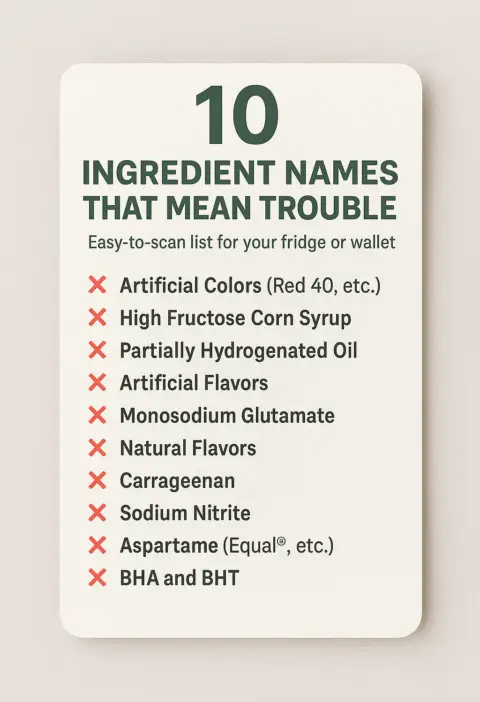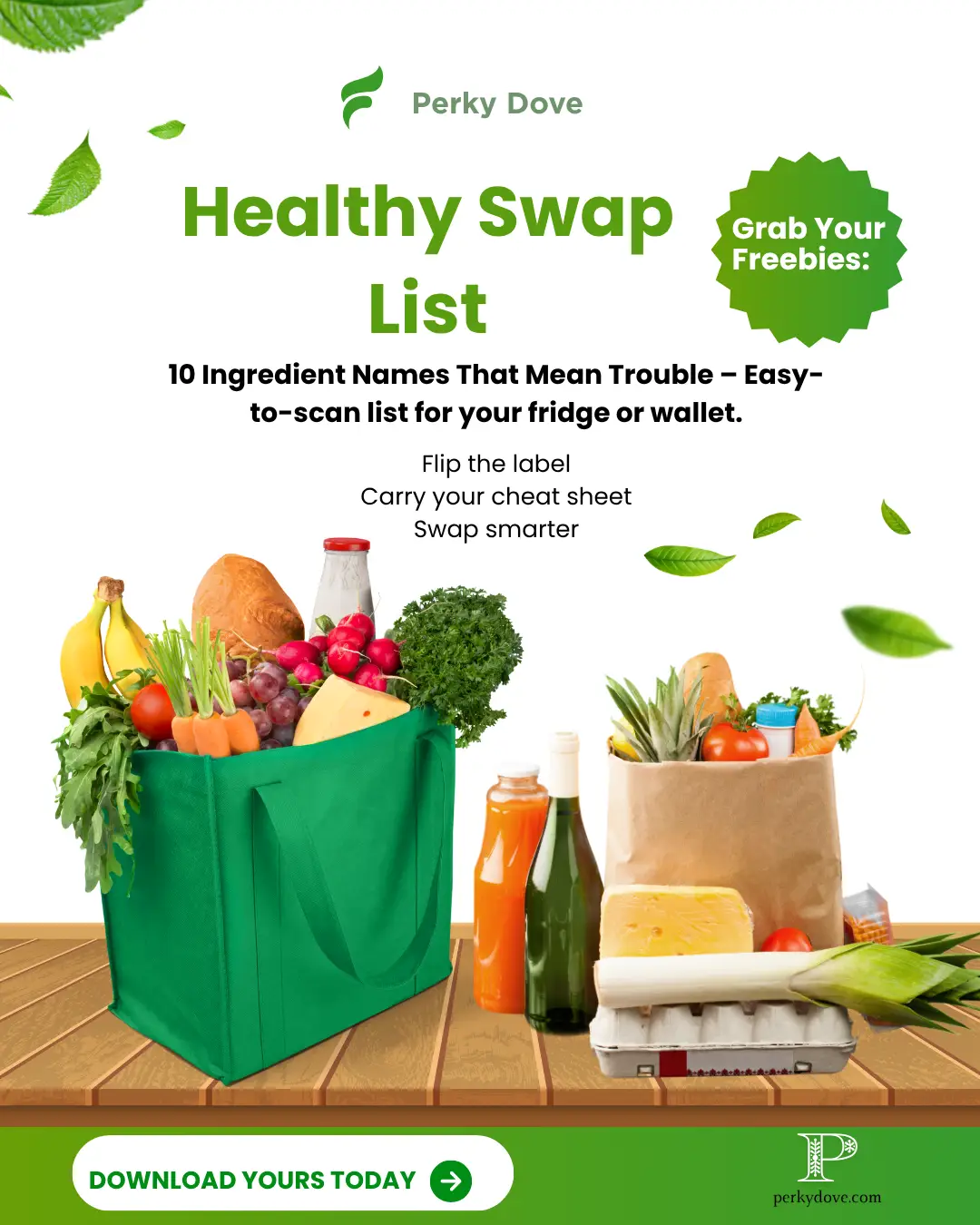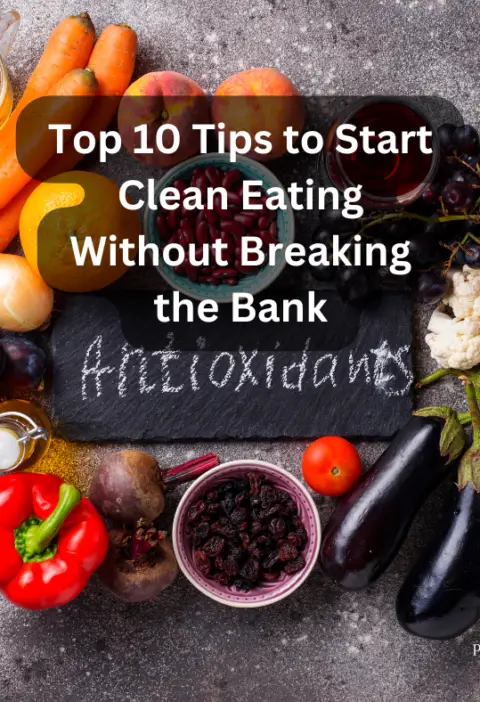Introduction: The Health Food Hustle
You asked for more, and here we are. After the buzz around What’s Hiding in Your So-Called Healthy Foods?, it became clear that many of us are ready to dig deeper into what we’re really eating. Just because something says “organic,” “keto-friendly,” or “gluten-free” doesn’t mean it’s nourishing your body.
In fact, many of today’s so-called healthy products are packed with questionable ingredients dressed up with fancy labels. Food marketers are clever, and we deserve to be even smarter.
In this post, we’re pulling back the curtain on 7 sneaky ingredients that hide in products you’d never suspect. Plus, you’ll get free printables to help you shop smarter—whether you’re standing in the grocery aisle or ordering online.
7 Sneaky Ingredients
1. Carrageenan
What it is: A thickener made from red seaweed. Sounds natural, right?
Where it hides: Almond milk, coconut milk, deli meats, yogurts, even some organic products.
Why it’s sneaky: Carrageenan has been linked to inflammation and digestive upset, especially in people with sensitive guts. The worst part? It’s allowed in products that are otherwise labeled as clean or organic.
2. Chicory Root Fiber (Inulin)
What it is: An added fiber that food companies use to pump up fiber content and help with texture.
Where it hides: Protein bars, low-carb snacks, fiber drinks, baked goods.
Why it’s sneaky: It sounds like a bonus, but for many people, especially those with IBS or gut sensitivities, chicory root can cause major bloating, gas, and discomfort.
3. Yeast Extract
What it is: A flavor enhancer that’s chemically similar to MSG.
Where it hides: Soups, broths, veggie burgers, frozen meals, and savory snacks.
Why it’s sneaky: It’s often used in place of MSG but can trigger the same symptoms—headaches, nausea, and fatigue. It’s also a sign your “natural” flavor boost is more chemical than kitchen-crafted.
4. Natural Flavors
What it is: A catch-all term for flavor chemicals derived from plant or animal sources—with many added solvents, preservatives, and synthetic components.
Where it hides: Practically everywhere—flavored water, granola bars, teas, cereals, and more.
Why it’s sneaky: It sounds innocent, but “natural flavors” can mean a cocktail of up to 100 undisclosed ingredients. It’s legal. It’s common. And it’s not as natural as you’d think.
5. Soy Protein Isolate
What it is: A highly processed protein powder extracted from soybeans.
Where it hides: Protein powders, “healthy” snack bars, meal replacement shakes, and plant-based meats.
Why it’s sneaky: It often comes from GMO soy and is extracted using chemical solvents like hexane. What you’re left with is a fraction of the original food—stripped of fiber and loaded with processing residue.
6. Sugar Alcohols (Erythritol, Maltitol, Sorbitol)
What it is: Low-calorie sweeteners used to replace sugar.
Where it hides: Keto snacks, sugar-free gum, protein bars, and ice creams.
Why it’s sneaky: They’re advertised as blood sugar-friendly, but can wreak havoc on your gut. Many people experience bloating, gas, or diarrhea from these sugar substitutes.
7. Vegetable Oils (Canola, Soybean, Corn, Safflower)
What it is: Highly refined oils extracted from seeds using heat and chemicals.
Where it hides: Chips, salad dressings, frozen meals, even “healthy” granola.
Why it’s sneaky: These oils are often oxidized and inflammatory, contributing to everything from poor heart health to brain fog. And they’re cheap, which is why they’re in so many processed foods.
BONUS: 10 Ingredient Names That Mean Trouble
Looking for an expanded list of suspicious ingredients flagged by regulatory and scientific bodies? Here’s a consumer-friendly breakdown with science-backed insight:
-
Partially Hydrogenated Oils (Trans fats): Raise LDL cholesterol, linked to heart disease and diabetes. Banned by the FDA in 2018.
➡️ FDA Trans Fat Ban -
High Fructose Corn Syrup (HFCS): Contributes to obesity, insulin resistance, and fatty liver. Dietary guidelines advise minimizing all added sugars.
➡️ FDA on HFCS -
Artificial Food Colorings (Red 40, Yellow 5, Blue 1): Linked to behavioral issues in children. FDA plans to phase them out; the EU requires warning labels.
➡️ FDA Announcements -
Sodium Nitrite / Nitrate: Preservatives in processed meat that form carcinogenic compounds. Classified as a human carcinogen by the WHO.
➡️ WHO Classification -
Brominated Vegetable Oil (BVO): Used in sodas; banned in 2024 after being linked to nerve and memory issues.
➡️ FDA BVO Update -
Potassium Bromate: Makes dough rise quickly; banned in many countries, possibly carcinogenic.
➡️ California OEHHA Proposition 65 List -
Titanium Dioxide: Common in candy coatings; banned in the EU due to DNA damage risk. Still permitted in the U.S.
➡️ EFSA Risk Assessment -
BHA and BHT: Preservatives linked to cancer and hormone disruption in animal studies. Legal but controversial.
➡️ NTP Report on BHA -
Aspartame: Artificial sweetener possibly carcinogenic according to WHO/IARC. Still approved for use in U.S./EU at limited daily intake levels.
➡️ WHO/IARC Statement -
Monosodium Glutamate (MSG): Safe at normal levels but can cause mild symptoms in sensitive individuals.
➡️ EFSA Review of MSG
These aren’t just red flags—they’re signals to pause, flip the package over, and make a more informed choice
So, What Can You Do?
You don’t need to panic—you just need a plan. Here are three quick steps to shop smarter:
-
Flip the label. Don’t trust the front of the box. Ingredients lists tell the real story.
-
Carry your cheat sheet. Use our free printable: “10 Ingredient Names That Mean Trouble.”
-
Swap smarter. Download our Pinterest-ready guide: “If You Buy This, Try This Instead.”
Remember: You vote with your fork and your dollar. Every time you choose truly clean ingredients, you’re sending a message. You deserve to eat food that fuels you—not tricks you.
🏱 Grab Your Freebies:
References:
-
U.S. Food and Drug Administration (FDA): www.fda.gov
-
European Food Safety Authority (EFSA): www.efsa.europa.eu
-
World Health Organization / IARC: www.iarc.who.int
-
National Toxicology Program (NTP): ntp.niehs.nih.gov
-
California OEHHA Proposition 65: oehha.ca.gov






